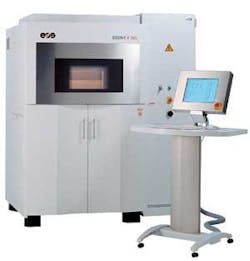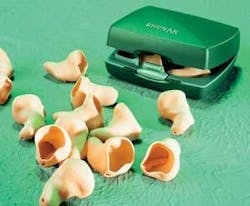e-Manufacturing means fast, flexible, and cost-effective production directly from 3D CAD data
Christof M. Stotko
Many industries face the problem of ever-shortening product life cycles while the product development phase increases steadily. In addition, customers start to require products that are customized to their individual wishes. As a consequence, many companies are not in the position to launch a product at exactly that point in time when the customer has a demand for it. To avoid this unfavorable situation, many companies add a considerable number of product variants to their portfolio. This leads to an increased complexity in product development, production, and sales without improving the market opportunities. As a result, there is less time to make money with each product on the market.
One possible solution is the implementation of new methods in product development, production, and sales. These methods have in common that they count highly on the integration of the customer into the value-added chain of a company. The extreme case would be the so-called “open innovation,” where the customer creates his or her individual innovation together with a company. However, “open innovation” requires a production method with which an intuitive product design can be supported. Laser sintering is such a technology. It allows production directly from CAD data and it enables freedom of design because the product design is not limited as is the case when choosing a conventional tooling-based product design.
How laser sintering works
Since the early 1990s, laser sintering has been a successful tool in product development. As a technical solution to the rapid prototyping concept it helps to significantly reduce time to market by supplying fully functional prototypes, molds, or forms within days based on 3D CAD data. Improvements in the technology and the increasing knowledge about it have enlarged the application fields in many ways. Today laser sintering is the key technology for e-Manufacturing, the fast, flexible, and cost-effective production directly from CAD files.
Laser sintering is a layer manufacturing technology (see Figures 1 and 2). Prerequisite for its use is the availability of 3D data of the object. The three-dimensional description is then converted into a set of slices that each describes a cross section of the part in a defined height. The laser sintering machine now builds up these slices layer by layer to create the desired object. In each layer the powder is fused using laser energy. With the help of a scanner the laser energy is “printed” onto the powder layer and thus creates a solidified layer that later will be part of the finished product. The next layer is then produced on top of the first and so on until the build is complete.
null
Manufacturing of direct plastic parts
The hearing aid industry has a particularly strong need to customize its products. Because the success of a hearing aid very much depends on its ability to adapt to the anatomy of the auditory canal, this industry cannot offer any mass-manufactured product.
The process of producing hearing aids with laser sintering is as follows:
- Take a copy of the auditory canal anatomy by creating a wax cast.
- Scan the wax cast with a scanner to create 3D data.
- Integrate an identification number in the 3D data that helps to identify the hearing aid shell after the laser sintering process.
- Laser sinter the shell (see Figure 3).
- Combine the laser sintered shell with the electronics components.
In the hearing aid industry laser sintering has become the manufacturing method of choice. The manufacturing process runs at the same efficiency, no matter whether a certain number of identical or individual products (one-offs) are produced. The build envelope of a laser sintering system can be filled with several hundred hearing aid shells-hundreds of products can thus be produced over night. e-Manufacturing unleashes its full potential: the ability to directly run a manufacturing process from 3D CAD data is crucial in the case where no two parts are the same. In the later stages of the product life cycle the data can be re-used in order to provide spare parts with the identical geometry as the original part. Apart from the geometry, every part can be distinguished by a serial number at the inside of the shell serving as patient identification code.
At the current state of laser sintering technology a yearly output of 100,000 hearing aid shells can be achieved with one single plastic laser sintering machine.
Hammtronic Joystick “HI-Drive”
FIT is one company that has successfully applied Direct Metal Laser Sintering (DMLS). This service bureau provided fast development and economic small series production of an innovative and complex joystick steering system for a construction vehicle. The joystick assembly consists of 15 plastic parts as well as electronics, mechanics, and switches. The requirements were: high reliability under demanding construction site conditions, high accuracy of the plastic parts due to assembly of complex geometries, and extremely short turnaround time due to presentation at a trade fair.
FIT decided to build 14 tools using DMLS. More than 70,000 injection molded production parts were manufactured with the laser sintered tools. One additional component was produced directly using plastic laser sintering. The total turnaround time was nine weeks, which included three weeks’ delay due to design changes from the customer. By choosing laser sintering as the production method, FIT was able to reduce the costs for this project by 50 percent compared to conventional procedures.
e-Manufacturing with laser sintering can be a viable solution in different industries. It is important to stress that this not only holds true in a rapid prototyping environment but especially in a series production environment of complex products that are offered in many varieties. e-Manufacturing gains the most impact in those cases where end products can be manufactured with laser sintering technologies either in plastics or in metal. By eliminating time- and cost-consuming detours through tooling processes, laser sintering end products can help certain industries gain a competitive edge over competitors.
As the application cases above show, laser sintering can help boost the economic aspects by providing fast access to adequate tools. This aspect even gains momentum if the required tools are of great complexity. As the example of the Hammtronic joystick proved, producing tools by laser sintering helps save precious time in the development process.
Laser sintering is not only a viable tool for rapid prototyping but increasingly becomes the manufacturing method of choice in industries that face a high number of varieties of complex product.
Dr. Christof M. Stotko is global marketing manager at EOS Electro Optical Systems (Krailling, Germany), www.eos.info.



